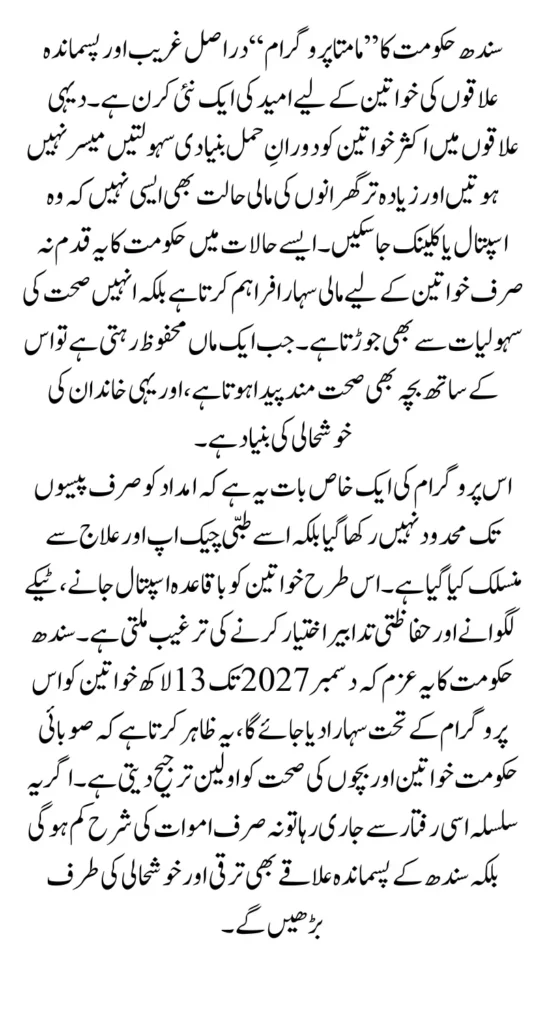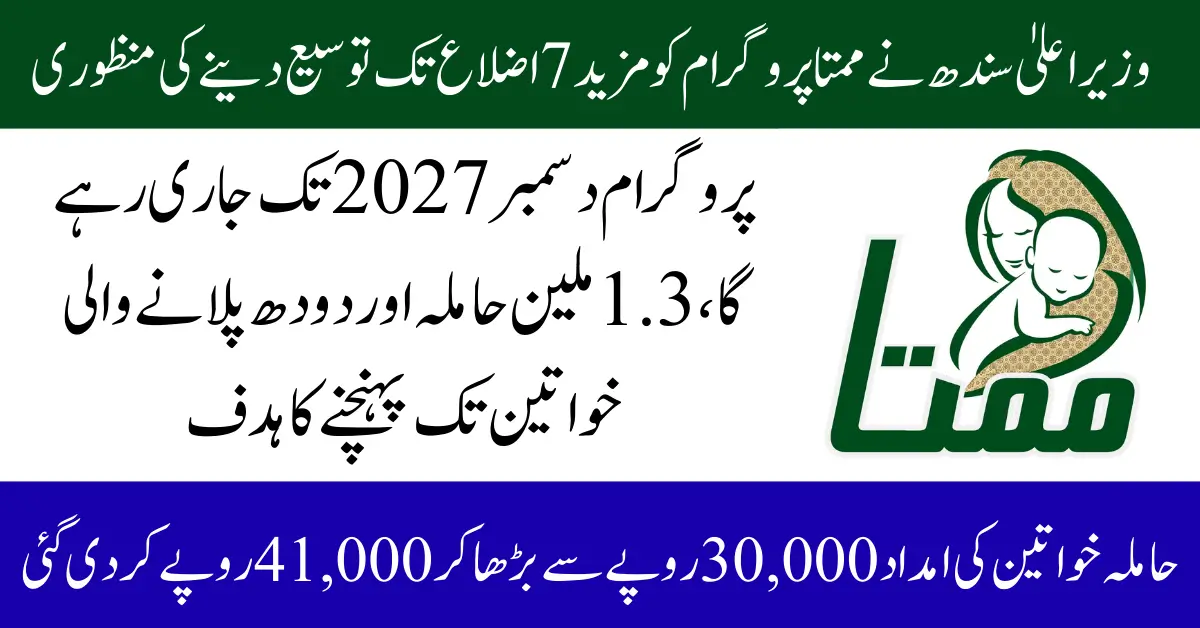Mamata Program Expansion
Mamata Program Expansion Sindh government has taken a bold step to strengthen maternal and child health by expanding the Mamata Program, officially known as the Maternal and Child Support Program (MCSP). This expansion not only extends the program to seven new districts, but it also raises the financial support for pregnant and lactating women from Rs 30,000 to Rs 41,000. The goal is to reach 1.3 million women by December 2027, making it one of the largest maternal health initiatives in the province’s history.

This program is not just about distributing cash; it is about connecting families to healthcare services, improving nutrition, reducing maternal and infant mortality, and providing dignity to women from rural and low-income households. The latest approval by Chief Minister Murad Ali Shah reflects a strong commitment to inclusive development and social protection in Sindh.
You Can Also Read: BISP Roster Error Solved Get Rs.13,500 Payment
What is the Mamata Program?
The Mamata Program is a conditional cash transfer initiative that provides financial assistance to pregnant and lactating women while linking the aid to specific healthcare milestones. This means women receive payments only when they attend health check-ups, give birth at health facilities, and complete postnatal visits. In this way, the program ensures that the financial help translates directly into improved maternal and child health outcomes.
The main objectives of the Mamata Program include:
- Supporting women during pregnancy and after childbirth
- Reducing maternal and child mortality in vulnerable districts
- Encouraging safe deliveries in healthcare facilities
- Providing nutrition and health awareness in rural areas
By combining financial relief with healthcare accountability, the program addresses both economic and medical barriers faced by thousands of women in Sindh.
You Can Also Read: Punjab Electric Taxi Scheme Interest Free For Youth Apply Now
Expansion to 7 New Districts
During the latest meeting of the Sindh Social Protection Authority, it was decided that the Mamata Program will now cover 22 districts in total. Previously active in 15 rural districts, the initiative has now been extended to:
- Larkana
- Sukkur
- Khairpur
- Shaheed Benazirabad
- Jamshoro
- Dadu
- Nowshera Feroze
This expansion is a vital move because these districts face high levels of poverty, poor health infrastructure, and increased maternal health risks. By including them, the Sindh government is targeting the regions where intervention is most needed, ensuring that women and children are not left behind.
You Can Also Read: Chief Minister of Punjab CM Bike Scheme 2025
Increased Financial Assistance Rs 41,000 for Mothers
One of the most significant updates in the Mamata Program is the increase in financial support. Eligible women will now receive Rs 41,000 over three years, compared to the earlier amount of Rs 30,000. The money will not be given in one installment but in phased payments, which are tied to critical healthcare check-points.
- Regular antenatal check-ups during pregnancy
- Delivery at a healthcare facility under trained supervision
- Postnatal visits to ensure the mother and child’s health
This system guarantees that mothers get continuous care and that financial support is invested in health and well-being, rather than being consumed all at once.
Healthcare Facilities & Implementation
The success of the Mamata Program depends not just on money, but also on the availability of quality healthcare. To make this possible, the initiative is being implemented through a strong network of 800 health centres across Sindh. Out of these, 740 centres are managed by the People’s Primary Healthcare Initiative (PPHI), while 62 are operated by the Health Department.
These centres offer a wide range of services including antenatal check-ups, delivery facilities, counselling, vaccination, and nutrition guidance. By linking financial aid to visits at these centres, the government is ensuring that mothers receive not only money but also essential medical support.
You Can Also Read: Himmat Card Rs 10500 For Eligiable People
Mamata Program Reach 2025
| Indicator | Current Status |
|---|---|
| Total Districts Covered | 22 |
| Health Centres Involved | 800 |
| Women Registered So Far | 770,000+ |
| Target Women by 2027 | 1.3 Million |
| Financial Support per Woman | Rs 41,000 |
Who Can Apply and How?
The Sindh government has set clear eligibility rules to make sure that the Mamata Program reaches only the deserving. Women who want to benefit must:
- Be at least 18 years old
- Have a valid Computerized National Identity Card (CNIC)
- Be a resident of one of the designated districts
- Be either pregnant or lactating at the time of registration
Registration Process
- Visit the nearest PPHI or Health Department health centre.
- Provide CNIC, proof of residence, and basic details.
- Fill out the official enrollment form.
- Complete required health check-ups to qualify for phased payments.
This simple process has been designed to make registration easier for women in rural communities who may face mobility and literacy barriers.
You Can Also Read: BISP 8171 Payment Deduction End
Government’s Vision for Maternal Protection
The expansion of the Mamata Program is part of a broader Rs 48.3 billion social protection package, with Rs 6.3 billion funded directly by the Sindh government. The program began in January 2023 and will run until December 2027, aiming to reach half of all pregnant and lactating women in targeted districts.
Chief Minister Murad Ali Shah has stressed that the program is not limited to cash distribution but is also about empowering women, improving healthcare access, and reducing poverty in rural Sindh. By making maternal health a priority, the government is not only saving lives but also investing in stronger families and healthier communities.
Conclusion
The expansion of the Mamata Program marks a turning point for maternal and child healthcare in Sindh. With financial support increased to Rs 41,000, coverage extended to 22 districts, and a clear goal of reaching 1.3 million women, the program promises long-term benefits for thousands of families.
By linking payments with healthcare visits, the initiative ensures that women are not just financially supported, but are also guided toward safer pregnancies and healthier children. This holistic approach shows how social protection, when combined with healthcare, can create lasting impact in vulnerable communities.
You Can Also Read: BISP Eligibility Expansion For Flood-affected People


